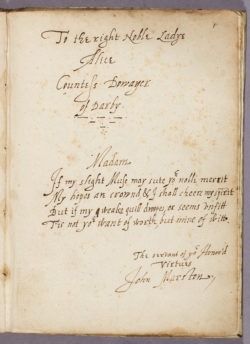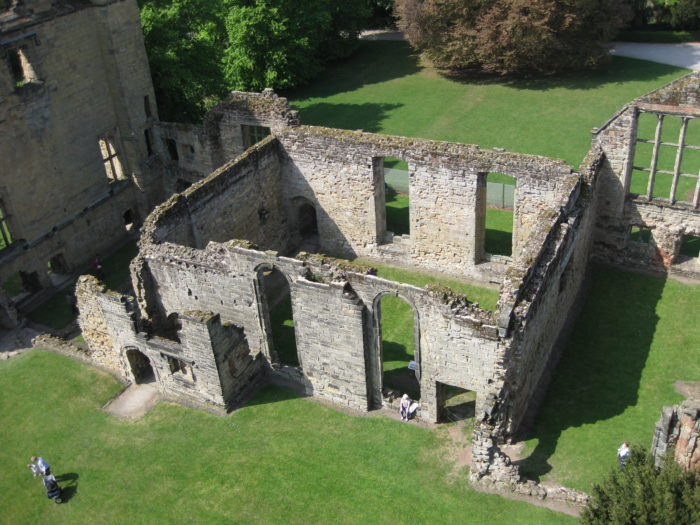The Entertainment at Ashby

Partly autograph manuscript of the Ashby Entertainment, HM EL 34 B9, The Huntington Library, San Marino, California.
The Ashby entertainment is Marston’s only masque, if it can be called that: it is really a household show performed in an intimate setting for the family of Henry Hastings, fifth Earl of Huntingdon. Staged at the family seat at Ashby, Leicestershire, in 1607, the show is devised as pastime for a visit by the Earl’s mother-in-law, Alice Spencer, dowager Countess of Derby, a prominent court lady and literary patron now married to her second husband, the Lord Keeper, Sir Thomas Egerton.
The show falls into three parts. There is a welcome for the Countess at the entrance to the estate, in the form of speeches by ‘an old enchantress’, Merimna, and the god Saturn. The second part was performed indoors, comprising a masque of four knights, four gentlemen, and their ladies, framed by a mythological dialogue between Cynthia and Ariadne. Finally, for the Countess’s departure from Ashby, Marston wrote a pastoral eclogue between a shepherd and a nymph, expressing their sorrow that her visit was ended. The entertainment concludes with the stage direction ‘So the Countess passed on until she came through the Little Park, where Niobe presented her with a cabinet, and so departed’ – words made famous by T. S. Eliot who used them out of context as an epigraph to his poem ‘Burbank with a Baedeker: Bleistein with a cigar’.
For the editor, this text is particularly fascinating as it was never printed by Marston, and survives only in two manuscript versions, one complete, now in the Huntington Library, California (as part of the Egerton papers), the other fragmentary, in the British Library, London. Marston manuscripts are very scarce, and these are the two most important examples. The Huntington manuscript is the formal version presented to the Countess by Marston as a memento of the occasion and a bid for patronage. Most of it was copied by a scribe, but Marston added a dedication in his own hand, and wrote in various corrections to the scribe’s work which we shall need to take account of. The British Library manuscript is incomplete and inferior in quality, but it is interesting because it has several readings that correct possible errors in the Huntington text. Our new editorial work should improve significantly on the text as it appears in the current standard edition.
Another main task will be to explore the significance of the occasion and its function as an expression of the family’s local prestige and their relation to the networks of aristocratic patronage in which the Countess was so important a figure. A tantalizing feature of the Huntington text is the fact that it is bound up with an associated manuscript in another hand, containing fourteen sets of verses each linked to a named lady. These were written by a local gentleman in the Hastings circle, Sir William Skipwith, and probably represent another contribution to the Countess’s welcome. While we shall not edit Skipwith’s verses as part of Marston’s show, they do help to establish how Marston’s text structured and intersected with a more elaborate body of local pageantry, and they tell us a lot about the provincial and political relationships which gave public significance to this seemingly private event.

